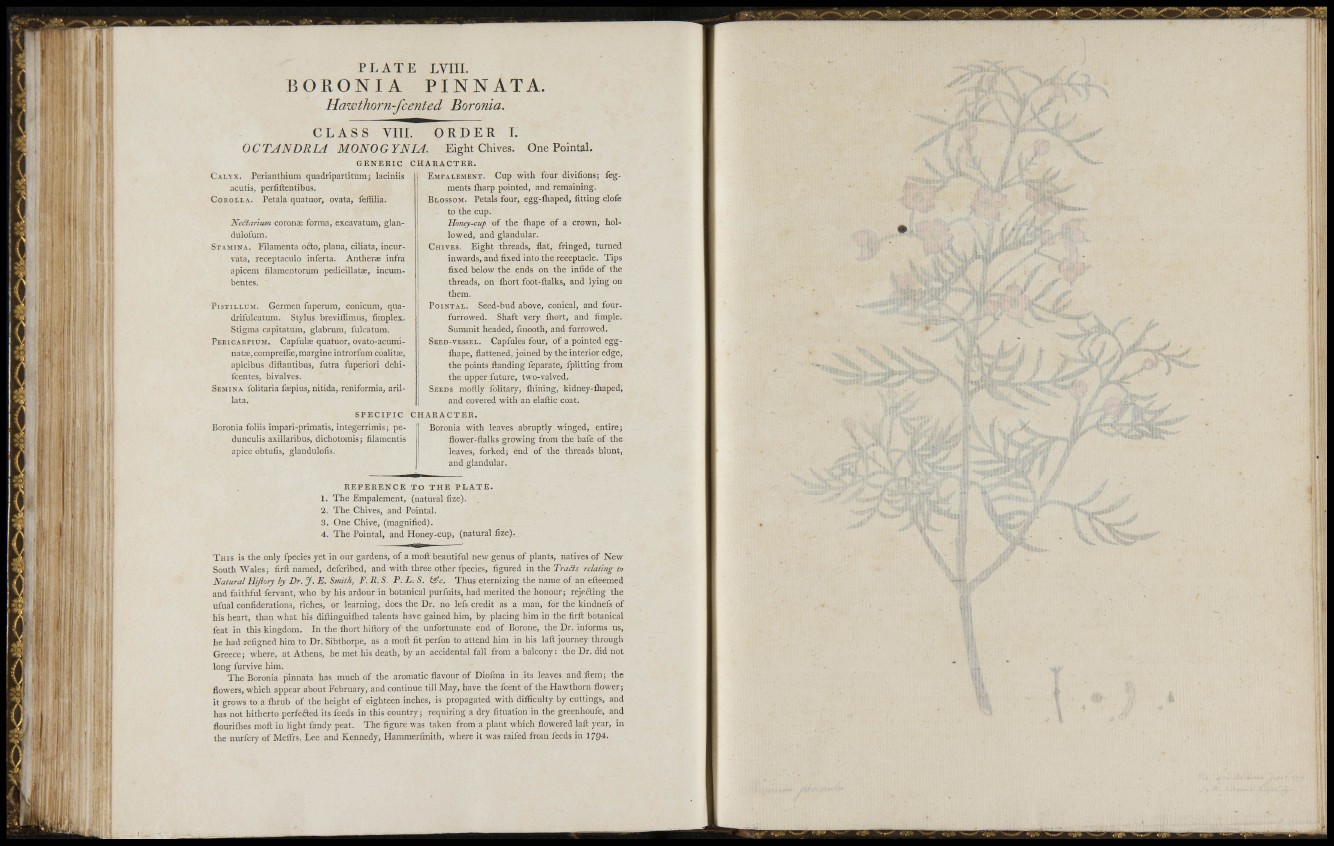
í
I í
P L A T E LVIII.
B O R O N I A PI N N AT A.
Haivthorn-fcejited Boronia.
C L A S S Vlli"" O RDE R L
OCTANDRIA MONOGYNIA. Eight Chives. One Pointal.
G E N E R I C CHARACTER.
CALYX. Perianthiura quadripartitura; laciniis
acutis, perfillentibus.
C O R O L L A . Pétala quatuor, ovata, feffilia.
Neilarium coronx forma, excavatum, glandulofum.
S T A M I N A . Pllamenta ofto, plana, ciliata, incurvata,
receptáculo inferta. Antherae Infra
apicem filamentorum pedicillatae, incumbentes.
P i s T i L L U M . Germen fuperum, conicum, quadrilulcatuni.
Stylus brevilfimus, fimplex.
Stigma capitatum, glabrum, fulcatum.
P E E I C A R P I U M . Capfulae quatuor, ovato-acuminataSjComprefíEe,
margine introrfum coalite,
apicibus diftantibus, futra fuperiori deliifcentes,
bivalves.
S E M I N A folitaria fsepius, nitida, reniformia, arillata.
S P E C I F I C
Boronia foliis impari-primatis, integerrimis; pedunculis
axillaribus, dichotomiá; filamentis
apice obtufis, glandulofis.
E M F A L E M E N T . Cup with four divifions; fegments
fliarp pointed, and remaining.
BLOSSOM. Petals four, egg-lliaped, fitting clofe
to the cup.
Honey-cup of the ihape of a crown, hollowed,
and glandular.
CHIVES. Eight threads, flat, fringed, turned
inwards, and fixed into the receptacle. Tips
fixed below the ends on the infide of the
threads, on Ihort foot-llalks, and lying on
them.
P O I N T A L . Seed-bud above, conical, and fourfurrowed.
Shaft very fliort, and limple.
Summit headed, fmooth, and farrowed.
SEED-VESSEL. Capfules four, of a pointed eggiliape,
flattened, joined by the interior edge,
the points ilanding feparate, fplitting from
the upper future, two-valved.
SEEDS moftly folitary, fliining, kidney-fliaped,
and covered with an elailic coat.
C H A R A C T E R .
Boronia with leaves abruptly winged, entire;
flower-flalks growing from the bafe of the
leaves, forked; end of the threads blunt,
and glandular.
R E F E R E N C E TO THE PLATE.
1. The Empalement, (natural lize).
2. The Chives, and Pointal.
3. One Chive, (magnified).
4. The Pointal, and Honey-cup, (natural fize).
T H I S is the only fpecies yet in our gardens, of a moil beautiful new genus of plants, natives of New
Soutli Wales; firtl named, defcribed, and with three other fpecies, figured in the T;vi<Sj relating to
Natural Hijlory by Dr. J. E. Smith, F. 1{. S. P. L. S. tsfc. Thus eternizing the name of an efteenied
and faithful fervant, who by his ardour in botanical purfuits, had merited the honour; rejefting the
ufual confiderations, riches, or learning, does the Dr. no lefs credit as a man, for the kindnefs of
his heart, than what his diftinguiflied talents have gained him, by placing him in the firft botanical
feat in this kingdom. In the fliort hiftory of the unfortunate end of Borone, the Dr. informs us,
he had refigned him to Dr. Sibthorpe, as a moft fit peribn to attend him in his laft journey through
Greece; where, at Athens, he met his death, by an accidental fall from a balcony: the Dr. did not
long furvive him.
The Boronia pinnata has much of the aromatic flavour of Diofma in its leaves and Hem; the
flowers, which appear about February, and continue till iMay, have the fcent of the Hawthorn flower;
it grows to a flirub of the height of eighteen inches, is propagated with difficulty by cuttings, and
has not hitherto perfeded its feeds in this country; requiring a dry fituation in the greenhoufe, and
flouriihes moft in light fandy peat. The figure was taken from a plant which flowered laft year, in
the nurfery of Meflrs. Lee and Kennedy, Hammerfmith, where it was raifed from feeds in 1704.
A
if;-
iii'?'
i!i r
il
ir
ir 1 :
111
i i :
- ill [
ili: ;
Ih il
ili :
n
ÌV